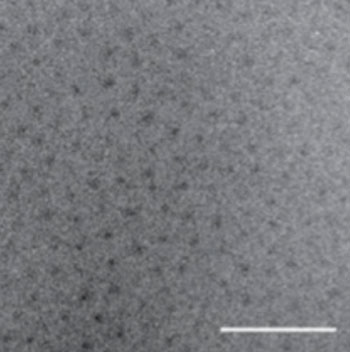Nanoparticle-Bound Paclitaxel Outperforms Abraxane in Mouse Cancer Models
|
By LabMedica International staff writers Posted on 16 Aug 2015 |

Image: Transmission electron micrograph (TEM) of the newly repackaged pharmaceutical. The dark spots are the water-insoluble cores of the nanoparticles, while the peptide chains are barely visible due to their low electron density and high degree of hydration (Photo courtesy of Dr. Ashutosh Chilkoti, Duke University).
A novel formulation that intercalated the toxic cancer drug paclitaxel within inert nanoparticles increased the potency of the drug in mouse models while reducing the severity of its adverse side effects.
Investigators at Duke University (Durham, NC, USA) were looking for a form of the chemotherapeutic drug paclitaxel that would perform better than today's preferred formulation known as Abraxane. Abraxane, also called nab-paclitaxel, is a formulation where paclitaxel is bound to albumin nanoparticles. Much of the clinical toxicity of regular paclitaxel is associated with the solvent Cremophor EL in which it is dissolved for delivery. In Abraxane paclitaxel is bonded to albumin as an alternative delivery agent to the more toxic solvent delivery method. This formulation was approved by the [US] Food and Drug Administration (Bethesda, MD, USA) in January 2005 for the treatment of breast cancer after failure of combination chemotherapy for metastatic disease or relapse within six months of adjuvant chemotherapy
The investigators worked with two mouse models: the first group of mice had human breast cancers growing in their own mammary glands, while the second group of mice had human prostate tumors growing under their skin. Both groups were treated with Abraxane or with a new formulation.
In this formation paclitaxel was conjugated to recombinant chimeric polypeptides (CPs) that spontaneously self-assembled into approximately 60 nanometer near-monodisperse nanoparticles that increased the systemic exposure of paclitaxel by sevenfold compared with the free drug and twofold compared with Abraxane. The tumor uptake of the nanoparticles was fivefold greater than the free drug and twofold greater than Abraxane.
Results published in the August 4, 2015, online edition of the journal Nature Communications revealed that in the mouse cancer models of human triple-negative breast cancer and prostate cancer, the paclitaxel nanoparticles induced near-complete tumor regression after a single dose in both tumor models, whereas at the same dose, no mice treated with Abraxane survived for more than 80 days (breast cancer) or 60 days (prostate cancer), respectively.
"The chemical bonds holding the polypeptide cage together are stable in blood, but dissolve in a tumor's lower pH levels," said first author Dr. Jayanta Bhattacharyya, a senior research scientist at Duke University. "This delivers the drug directly to the tumor and helps prevent it from randomly absorbing into healthy tissue, reducing side effects."
Related Links:
Duke University
[US] Food and Drug Administration
Investigators at Duke University (Durham, NC, USA) were looking for a form of the chemotherapeutic drug paclitaxel that would perform better than today's preferred formulation known as Abraxane. Abraxane, also called nab-paclitaxel, is a formulation where paclitaxel is bound to albumin nanoparticles. Much of the clinical toxicity of regular paclitaxel is associated with the solvent Cremophor EL in which it is dissolved for delivery. In Abraxane paclitaxel is bonded to albumin as an alternative delivery agent to the more toxic solvent delivery method. This formulation was approved by the [US] Food and Drug Administration (Bethesda, MD, USA) in January 2005 for the treatment of breast cancer after failure of combination chemotherapy for metastatic disease or relapse within six months of adjuvant chemotherapy
The investigators worked with two mouse models: the first group of mice had human breast cancers growing in their own mammary glands, while the second group of mice had human prostate tumors growing under their skin. Both groups were treated with Abraxane or with a new formulation.
In this formation paclitaxel was conjugated to recombinant chimeric polypeptides (CPs) that spontaneously self-assembled into approximately 60 nanometer near-monodisperse nanoparticles that increased the systemic exposure of paclitaxel by sevenfold compared with the free drug and twofold compared with Abraxane. The tumor uptake of the nanoparticles was fivefold greater than the free drug and twofold greater than Abraxane.
Results published in the August 4, 2015, online edition of the journal Nature Communications revealed that in the mouse cancer models of human triple-negative breast cancer and prostate cancer, the paclitaxel nanoparticles induced near-complete tumor regression after a single dose in both tumor models, whereas at the same dose, no mice treated with Abraxane survived for more than 80 days (breast cancer) or 60 days (prostate cancer), respectively.
"The chemical bonds holding the polypeptide cage together are stable in blood, but dissolve in a tumor's lower pH levels," said first author Dr. Jayanta Bhattacharyya, a senior research scientist at Duke University. "This delivers the drug directly to the tumor and helps prevent it from randomly absorbing into healthy tissue, reducing side effects."
Related Links:
Duke University
[US] Food and Drug Administration
Latest BioResearch News
- Genome Analysis Predicts Likelihood of Neurodisability in Oxygen-Deprived Newborns
- Gene Panel Predicts Disease Progession for Patients with B-cell Lymphoma
- New Method Simplifies Preparation of Tumor Genomic DNA Libraries
- New Tool Developed for Diagnosis of Chronic HBV Infection
- Panel of Genetic Loci Accurately Predicts Risk of Developing Gout
- Disrupted TGFB Signaling Linked to Increased Cancer-Related Bacteria
- Gene Fusion Protein Proposed as Prostate Cancer Biomarker
- NIV Test to Diagnose and Monitor Vascular Complications in Diabetes
- Semen Exosome MicroRNA Proves Biomarker for Prostate Cancer
- Genetic Loci Link Plasma Lipid Levels to CVD Risk
- Newly Identified Gene Network Aids in Early Diagnosis of Autism Spectrum Disorder
- Link Confirmed between Living in Poverty and Developing Diseases
- Genomic Study Identifies Kidney Disease Loci in Type I Diabetes Patients
- Liquid Biopsy More Effective for Analyzing Tumor Drug Resistance Mutations
- New Liquid Biopsy Assay Reveals Host-Pathogen Interactions
- Method Developed for Enriching Trophoblast Population in Samples
Channels
Clinical Chemistry
view channel
POC Breath Diagnostic System to Detect Pneumonia-Causing Pathogens
Pseudomonas aeruginosa is a major cause of hospital-acquired and ventilator-associated pneumonia, particularly in lung transplant recipients and patients with structural lung disease. Its ability to form... Read more
Online Tool Detects Drug Exposure Directly from Patient Samples
Doctors often rely on patient interviews and medical records to determine what medications a person has taken, but this information is frequently incomplete. People may forget drugs they used, take over-the-counter... Read moreMolecular Diagnostics
view channel
Rapid Diagnostic Breakthrough Simultaneously Detects Resistance and Virulence in Klebsiella Pneumoniae
Antibiotic resistance is a steadily escalating threat to global healthcare, making common infections harder to treat and increasing the risk of severe complications. One of the most concerning pathogens... Read more
DNA Detection Platform Enables Real-Time Molecular Detection
A next-gen DNA detection platform enables real-time molecular detection by detecting nucleic acids directly without enzymes or thermocyclers, thereby slashing costs, reducing complexity, and boosting reliability... Read moreHematology
view channel
MRD Tests Could Predict Survival in Leukemia Patients
Acute myeloid leukemia is an aggressive blood cancer that disrupts normal blood cell production and often relapses even after intensive treatment. Clinicians currently lack early, reliable markers to predict... Read more
Platelet Activity Blood Test in Middle Age Could Identify Early Alzheimer’s Risk
Early detection of Alzheimer’s disease remains one of the biggest unmet needs in neurology, particularly because the biological changes underlying the disorder begin decades before memory symptoms appear.... Read more
Microvesicles Measurement Could Detect Vascular Injury in Sickle Cell Disease Patients
Assessing disease severity in sickle cell disease (SCD) remains challenging, especially when trying to predict hemolysis, vascular injury, and risk of complications such as vaso-occlusive crises.... Read more
ADLM’s New Coagulation Testing Guidance to Improve Care for Patients on Blood Thinners
Direct oral anticoagulants (DOACs) are one of the most common types of blood thinners. Patients take them to prevent a host of complications that could arise from blood clotting, including stroke, deep... Read moreImmunology
view channel
Blood Test Could Identify Colon Cancer Patients to Benefit from NSAIDs
Colon cancer remains a major cause of cancer-related illness, with many patients facing relapse even after surgery and chemotherapy. Up to 40% of people with stage III disease experience recurrence, highlighting... Read moreBlood Test Could Detect Adverse Immunotherapy Effects
Immune checkpoint inhibitors have transformed cancer treatment, but they can also trigger serious immune-related adverse events that damage healthy organs and may become life-threatening if not detected early.... Read moreMicrobiology
view channel
Breakthroughs in Microbial Analysis to Enhance Disease Prediction
Microorganisms shape human health, ecosystems, and the planet’s climate, yet identifying them and understanding how they are related remains a major scientific challenge. Even with modern DNA sequencing,... Read more
Blood-Based Diagnostic Method Could Identify Pediatric LRTIs
Lower-respiratory tract infections (LRTIs) are a leading cause of illness and death worldwide, and pneumonia is the leading infectious cause of death in children under five, claiming the lives of over... Read morePathology
view channel
Rapid Low-Cost Tests Can Prevent Child Deaths from Contaminated Medicinal Syrups
Medicinal syrups contaminated with toxic chemicals have caused the deaths of hundreds of children worldwide, exposing a critical gap in how these products are tested before reaching patients.... Read more
Tumor Signals in Saliva and Blood Enable Non-Invasive Monitoring of Head and Neck Cancer
Head and neck cancers are among the most aggressive malignancies worldwide, with nearly 900,000 new cases diagnosed each year. Monitoring these cancers for recurrence or relapse typically relies on tissue... Read more
Common Health Issues Can Influence New Blood Tests for Alzheimer’s Disease
Blood-based tests for Alzheimer’s disease are transforming diagnosis by offering a simpler alternative to spinal taps and brain imaging. However, many people evaluated at memory clinics also live with... Read more
Blood Test Formula Identifies Chronic Liver Disease Patients with Higher Cancer Risk
Chronic liver disease affects millions worldwide and can progress silently to hepatocellular carcinoma (HCC), one of the deadliest cancers globally. While surveillance guidelines exist for patients with... Read moreTechnology
view channel
Machine Learning Models Diagnose ALS Earlier Through Blood Biomarkers
Amyotrophic lateral sclerosis (ALS) is a rapidly progressive neurodegenerative disease that is notoriously difficult to diagnose in its early stages. Early symptoms often overlap with other neurological... Read more
Artificial Intelligence Model Could Accelerate Rare Disease Diagnosis
Identifying which genetic variants actually cause disease remains one of the biggest challenges in genomic medicine. Each person carries tens of thousands of DNA changes, yet only a few meaningfully alter... Read moreIndustry
view channel
BD and Penn Institute Collaborate to Advance Immunotherapy through Flow Cytometry
BD (Becton, Dickinson and Company, Franklin Lakes, NJ, USA) has entered into a strategic collaboration with the Institute for Immunology and Immune Health (I3H, Philadelphia, PA, USA) at the University... Read more






















